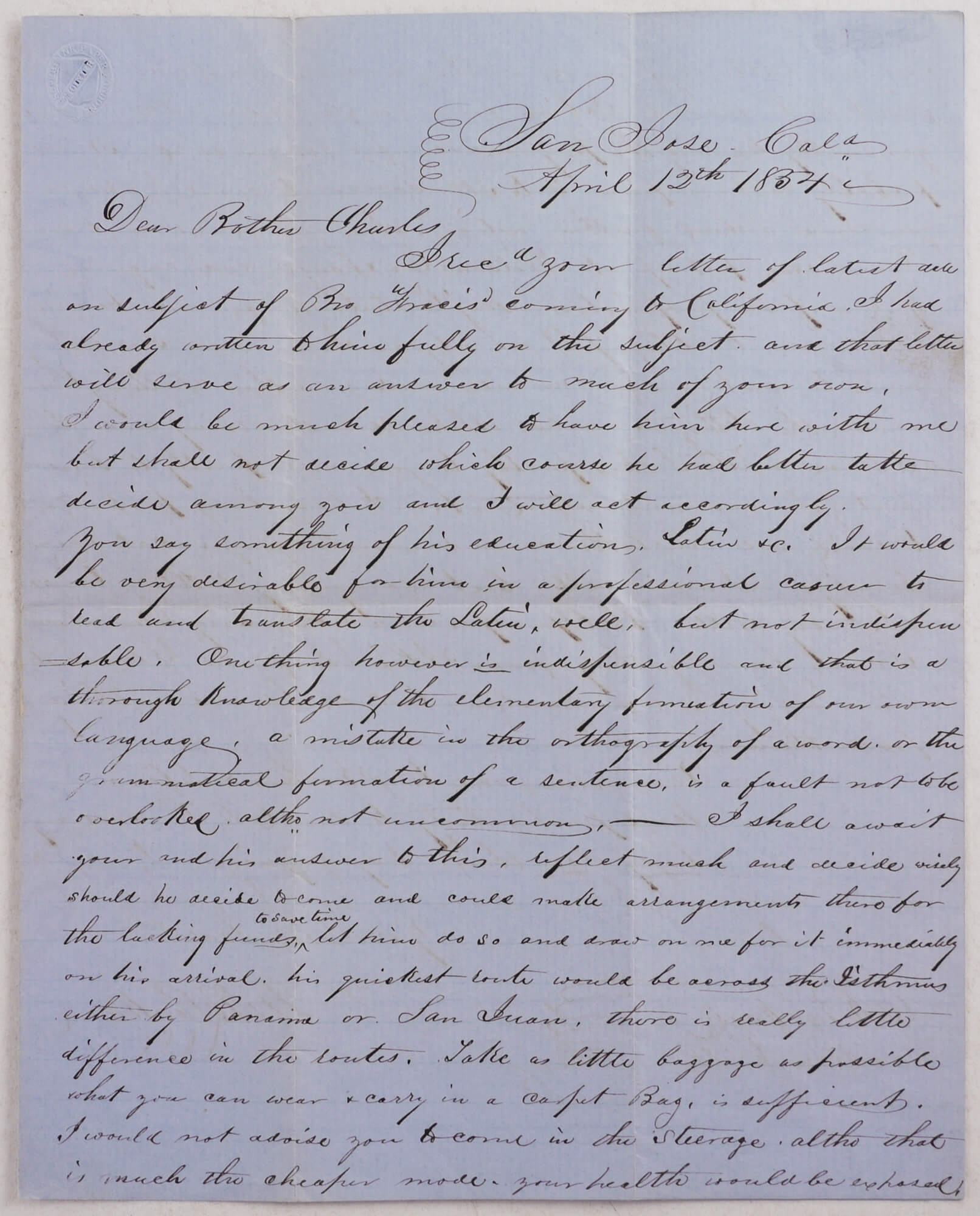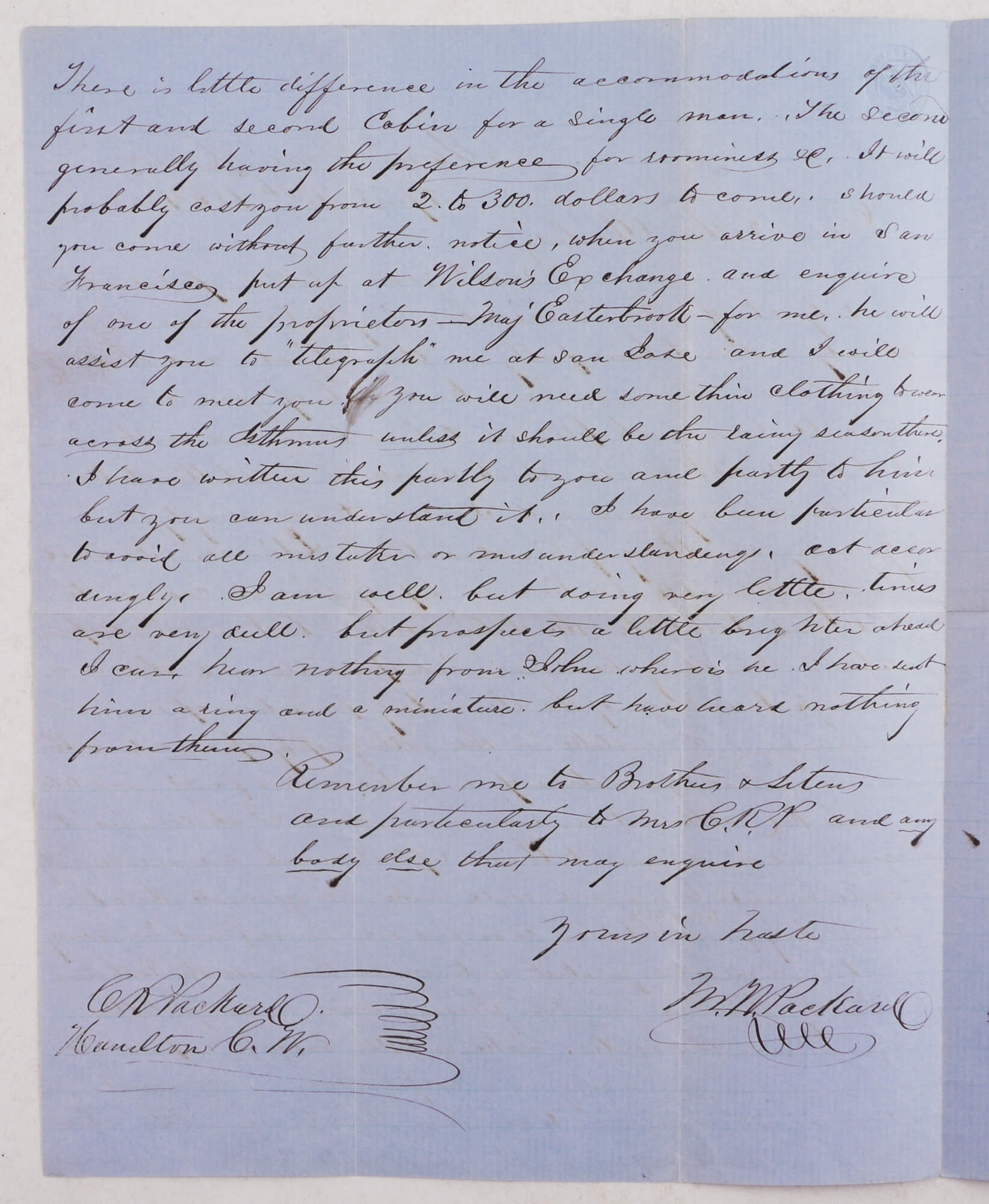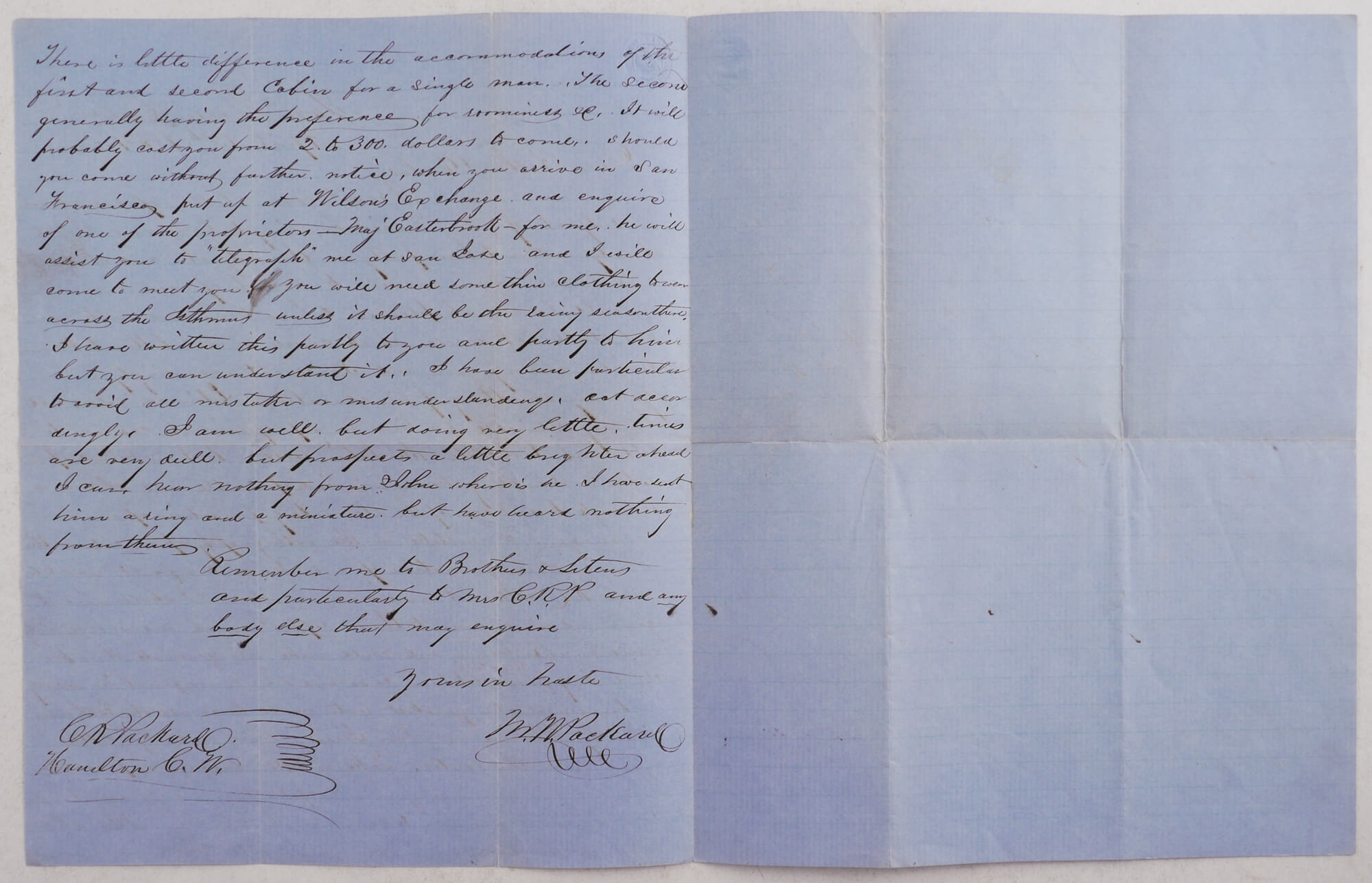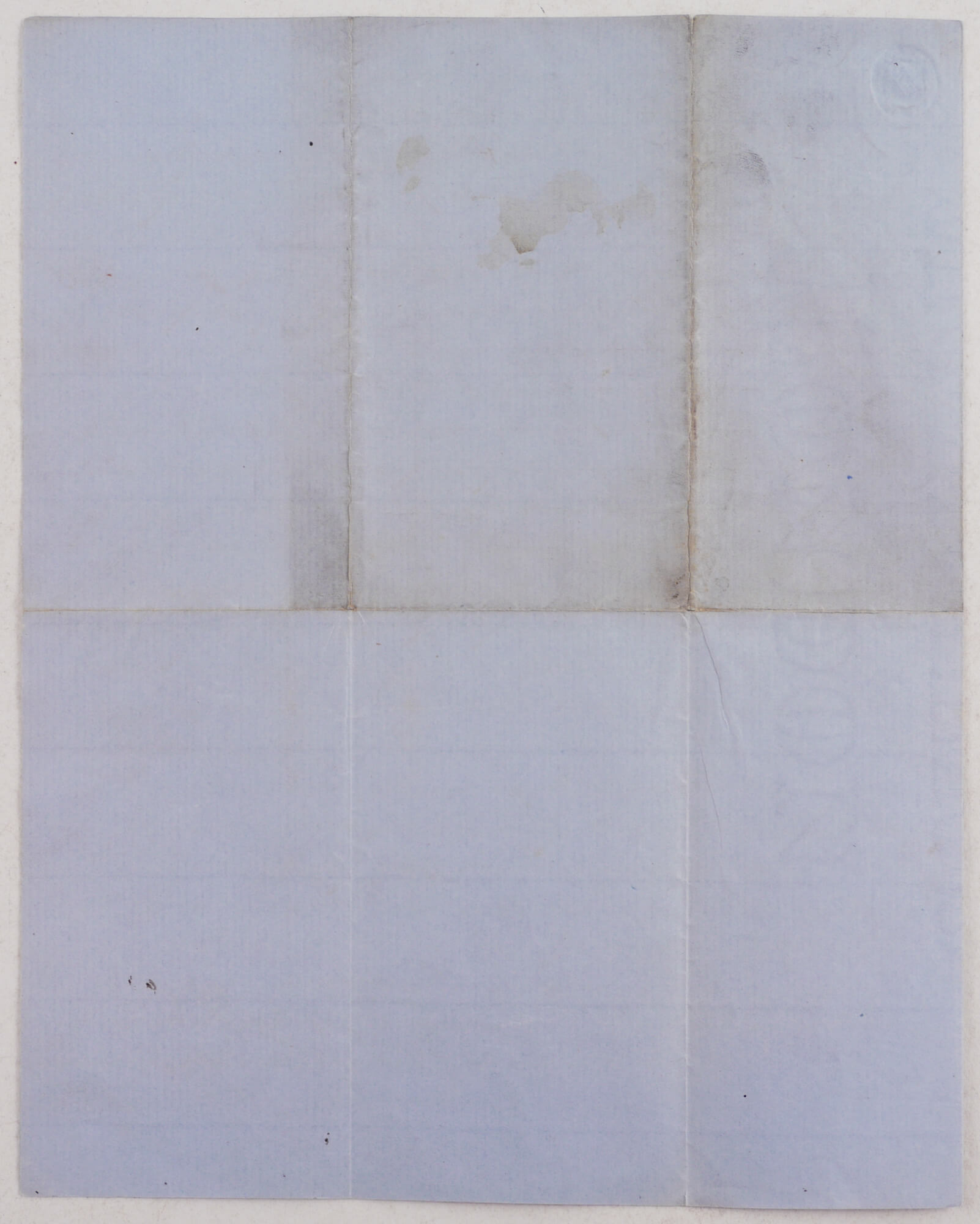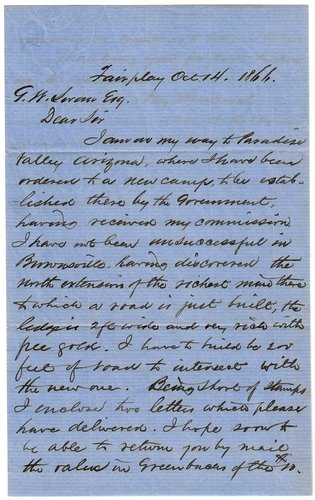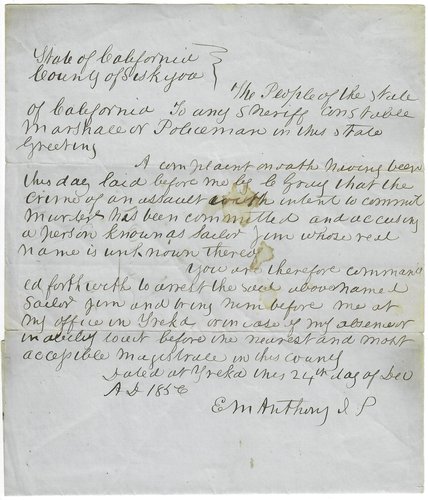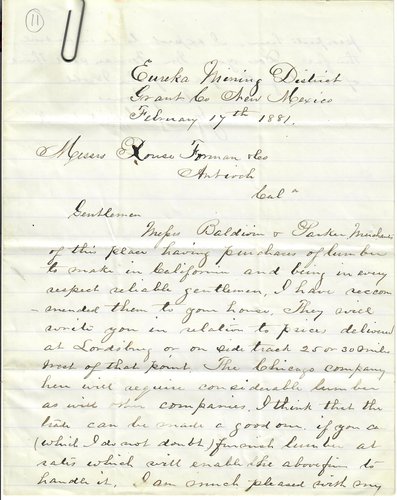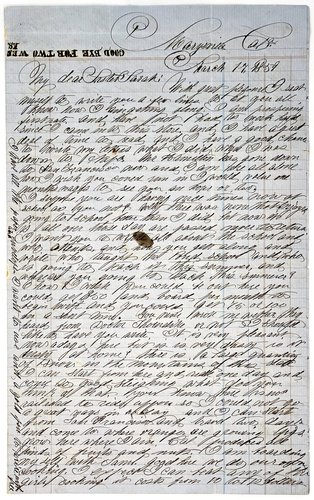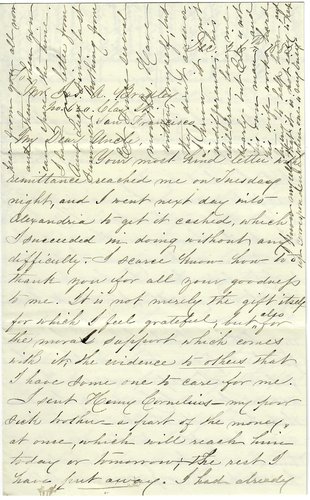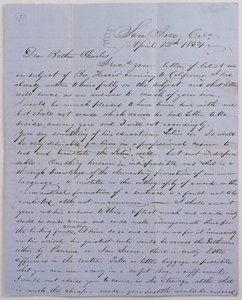
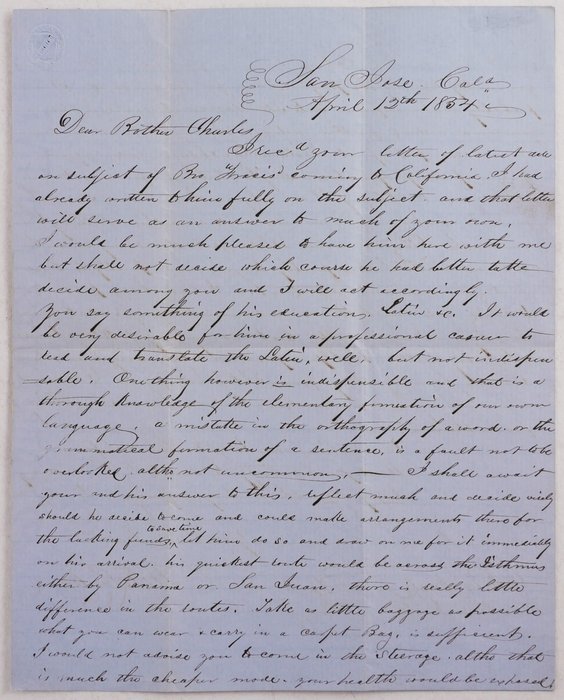
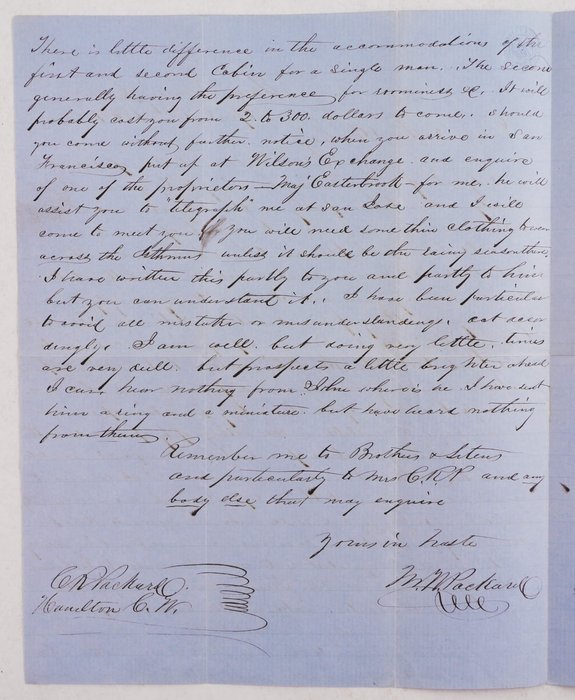
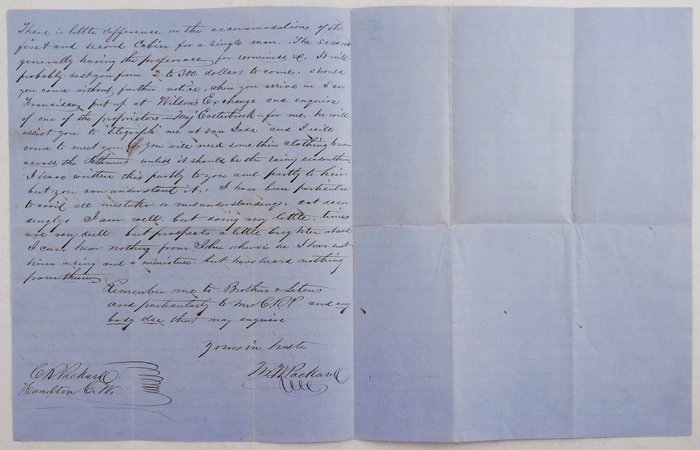
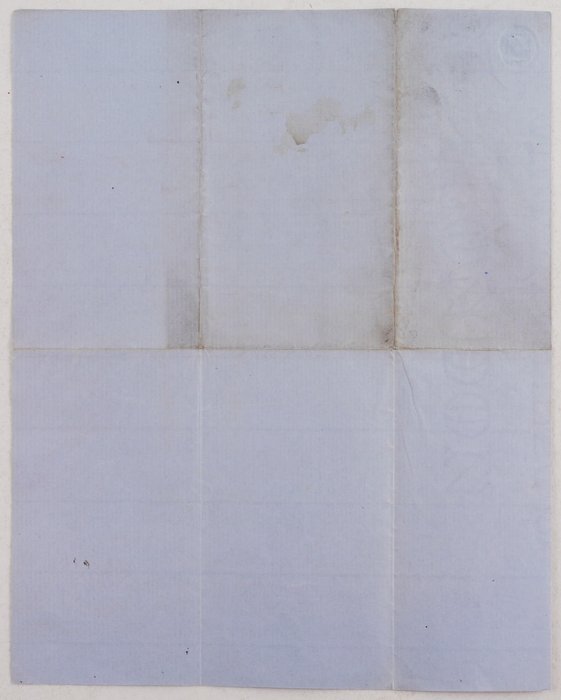
#MA71
April 1854
Quarto bifolium ca. 25,5x20 cm (10 x 8 in). 2 pp. Brown ink on blueish watermarked laid paper (watermark "Moinier's London"). Fold marks, paper slightly age-toned, but overall a very good letter.
A historically interesting California Gold Rush letter, giving details on the quickest way to get to California from the United States’ East Coast - via the Isthmus of Central America, crossing either at San Juan (Nicaragua) or Panama.
The letter was written by San Jose resident M. W. Packard (ca. 1822-?) to his brother Charles R. Packard - at the time, one of three professors of music in Hamilton, Ontario, Canada West (1853 Hamilton And Dundas Directory). M. Packard discusses Charles’ and presumably, their younger brother’s (Francis) trip to San Jose, suggesting the best possible route to California, the most comfortable accommodation in steamboats, and the finest hotel in San Francisco. Providing a vivid insight into the peculiarities of North American migrants’ journeys to California, the letter dates to the end of the California Gold Rush (1849-1855), when the tide of migration from Canada to the United States relatively slowed after its peak (approximately 40,000 migrants) in 1849-1850.
In the letter, the author, who apparently moved to the US three years earlier, plans his brothers’ travel itinerary and recommends taking the quickest and most popular route to California across the Isthmus either by Panama or San Juan. M. W. also elaborates upon peculiarities of accommodation in steamboats, giving preference to the second cabin for roominess and indicating an approximate price for the journey (200-300$). The author warns his brothers to “...take as little baggage as possible”, apparently not to overburden themselves while crossing the Panamanian jungle by foot or horseback (The Isthmus route was traveled from the east coast of the US to Panama (by steamships), through the Panamian jungle (by foot or on horseback), and up the coast of San Francisco (by ship). The journey took from 6 to 8 weeks. During the trip, the travelers often faced the risks of catching Malaria, Cholera, etc.). Upon arrival in California, M. W. recommends to “...put up at Wilson’s Exchange,” San Francisco’s principal and most luxurious hotel, built in 1850 by a theatrical manager and miner Baily Sargent. The second brick building erected upon Sansome Street, Wilson’s Exchange (1850-1896; later American Exchange) had 153 rooms with prices ranging from 6 to 10$ a day. With average receipts from 17,000$ to 18,000$ a month, the hotel was constructed and furnished on a scale of grandeur and magnificence previously unknown to San Francisco (San Francisco Chronicle/ 29 Jan 1896, p. 9). From the mid-1850s, Wilson’s Exchange had several lessees, among them being W. W. Eastabrook, whom the author, M. W. Packard, mentions in his letter: “...and enquire of one of the proprietors - Maj Easterbrook - for me he will assist you to ‘telegraph’ me at San Jose….” The California State Telegraph Co. line between San Francisco and San Jose opened six months before this letter was written and at the time was still considered a novelty, which explains why the author uses quotation marks with the word telegraph. An interesting passage about Francis’ education subtly reveals the state of literacy and job market in California of the 1850s. In 1847, when the state was annexed from Mexico and became incorporated into the US, California had one of the largest populations of Spanish speakers in the US, with only a few hundred literate residents out of 26,000 people (2% literacy rate). Although in 1849, California established Spanish and English as the state’s official languages, all business matters and high-ranking positions required a profound knowledge of English. Against this background, the author of the letter writes: “One thing however is indispensable and that is a thorough knowledge of the elementary formation of our own language, a mistake in the orthography of a word, or the grammatical formation of a sentence, is a fault not to be overlooked, although not uncommon.”
Overall, a historically important California Gold Rush letter, providing details on the quickest route to California from North America, unveiling one of the fanciest places in San Francisco, and subtly revealing the state of education in California in the 1850s.
It is highly likely that Charles R. Packard traveled to California in the mid-1850s and returned to Canada by 1858, since Shepard’s Hamilton City Directory of 1856 omits his name from the list of Hamilton residents, but indicates him in the next city directory published in 1858.
The text of the letter (spelling and syntax are original):
“Dear Brother Charles
I read your letter of latest date on subject of Bro Francis coming to California. I had already written to him fully on the subject and that letter will serve as an answer to much of your own. I would be much pleased to have him here with me but shall not decide which course he had better take, decide among you and I will act accordingly. You say something of his education. Latin etc. It would be very desirable for him in a professional career to read and translate the Latin well, but not indispensable. One thing however is indispensable and that is a thorough knowledge of the elementary formation of our own language, a mistake in the orthography of a word, or the grammatical formation of a sentence, is a fault not to be overlooked, although not uncommon. I shall await your and his answer to this, reflect much and decide wisely. Should he decide to come and could make arrangement there for the lacking funds to save time, let him do so and draw on me for it immediately on his arrival. His quickest route would be across the Isthmus either by Panama or San Juan. There is really little difference in the routes. Take as little baggage as possible what you can wear & carry in a carpet bag is sufficient. I would not advise you to come in the steerage, although that is much the cheaper mode, your health would be exposed.
There is little difference in the accommodations of the first and second cabin for a single man. The second generally having the preference for roominess etc. It will probably cost you from 2 to 300 dollars to come. Should you come without further notice, when you arrive in San Francisco put up at Willson’s Exchange and enquire of one of the proprietors - Maj Easterbrook - for me he will assist you to “telegraph” me at San Jose and I will come to meet you. You will need some thin clothing to wear across the Isthmus unless it should be the rainy season there. I have written this partly to you and partly to him, but you can understand it. I have been particular to avoid all mistakes or misunderstandings, act accordingly. I am well but doing very little. Times are very dull, but prospects a little brighter ahead. I can hear nothing from John, where is he. I have sent him a ring and a miniature, but have heard nothing from them.
Remember me to Brothers and Sisters and particularly to Mrs. CRP and anybody else that may enquire.
Yours in haste, M.W. Packard.”

